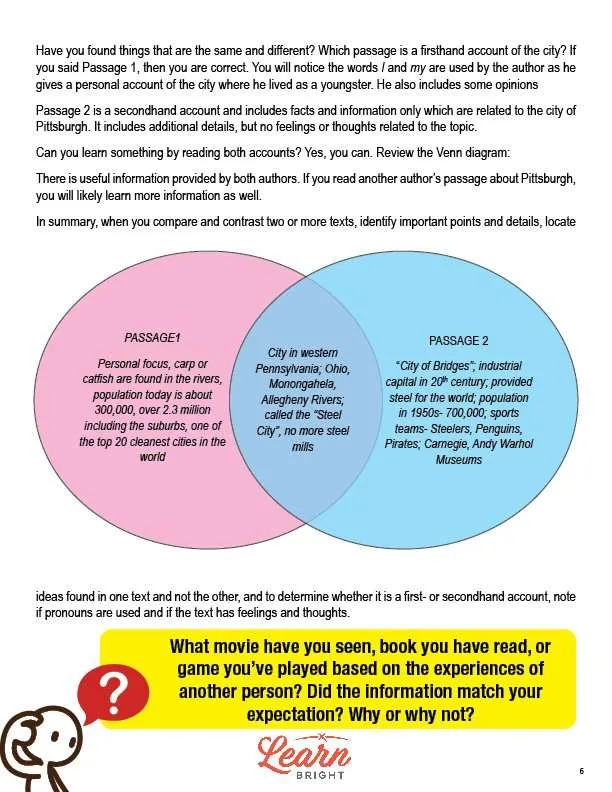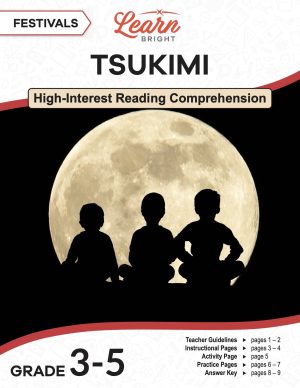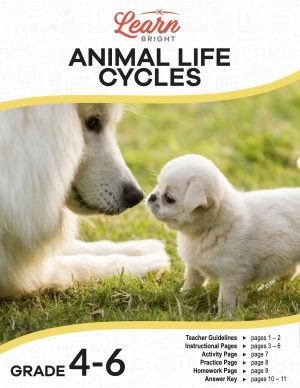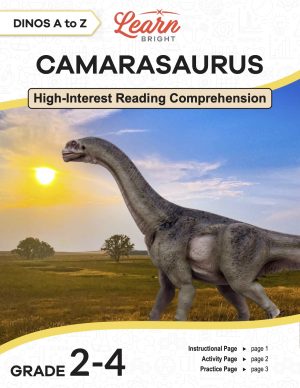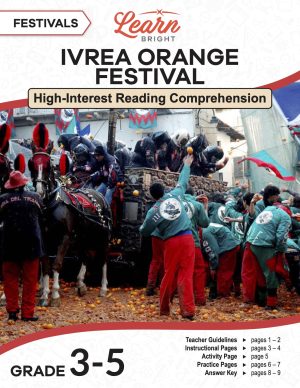Description
What our Compare and Contrast – Nonfiction lesson plan includes
Lesson Objectives and Overview: Compare and Contrast – Nonfiction teaches students strategies for effectively comparing and contrasting nonfiction texts. At the end of the lesson, students will be able to compare and contrast a firsthand and secondhand account of the same event or topic; describe the differences in focus and the information provided. This lesson is for students in 4th grade.
Classroom Procedure
Every lesson plan provides you with a classroom procedure page that outlines a step-by-step guide to follow. You do not have to follow the guide exactly. The guide helps you organize the lesson and details when to hand out worksheets. It also lists information in the yellow box that you might find useful. You will find the lesson objectives, state standards, and number of class sessions the lesson should take to complete in this area. In addition, it describes the supplies you will need as well as what and how you need to prepare beforehand. To prepare for this lesson ahead of time, you can pair students for the activity, find two passages or texts for the activity, and copy the handouts.
Options for Lesson
Included with this lesson is an “Options for Lesson” section that lists a number of suggestions for activities to add to the lesson or substitutions for the ones already in the lesson. If you’d to add another activity to the lesson, you can split the class into two groups, one of which will sit in on another class or activity and then share information about it with students from the second group; each of group of students will then write about the event, illustrating the differences between first and secondhand accounts. You can also have students visit the library and identify books that are written as firsthand and secondhand accounts.
Teacher Notes
The teacher notes page includes a paragraph with additional guidelines and things to think about as you begin to plan your lesson. This page also includes lines that you can use to add your own notes as you’re preparing for this lesson.
COMPARE AND CONTRAST – NONFICTION LESSON PLAN CONTENT PAGES
Firsthand Versus Secondhand
The Compare and Contrast – Nonfiction lesson plan includes four content pages. The lesson begins by telling students that, in their life, they will both experience events themselves and hear about events from other people. If you go to a party, your description is a firsthand account. If you tell someone about the party and they then tell someone else about it, that is a secondhand account, because they weren’t also at the party and are repeating what you said.
When writing, authors can share information as either firsthand or secondhand accounts. For firsthand accounts, the person who is writing was or is part of the event. They will write using words like “I” and “we.” They will also likely include their thoughts and feelings about the event.
For secondhand accounts, the person who is writing was or is not part of the event. They are describing events that happened to someone else, and will use words like “he,” “she,” or “they.” They probably won’t include thoughts or feelings, but will stick to the facts. Knowing how to compare and contrast different accounts of the same event is a very useful skill.
Comparing and Contrasting Passages
Different authors will write about the same event in a different way. People have written many, many books about Abraham Lincoln, for example. Reading different books will teach you different things. As you read, you can compare (find similarities) and contrast (find differences) the different authors’ perspectives.
Next, the lesson includes two passages about Pittsburgh. It then asks students if they’ve found and similarities or differences in the two passages. It also asks them to identify which passage is a firsthand account and which is a secondhand account, and how they determined which was which.
You can learn new things about the topic by reading both accounts. The lesson includes a Venn diagram of the information from each passage. The Venn diagram shows that each passage includes a lot of unique information.
When comparing and contrasting, make sure to look for significant details, pay attention to the ideas found in only one text, and determine whether it’s a first- or secondhand account by noting whether they use pronouns and whether or not it includes thoughts and feelings.
COMPARE AND CONTRAST – NONFICTION LESSON PLAN WORKSHEETS
The Compare and Contrast – Nonfiction lesson plan includes three worksheets: an activity worksheet, a practice worksheet, and a homework assignment. You can refer to the guide on the classroom procedure page to determine when to hand out each worksheet.
VENN DIAGRAM ACTIVITY WORKSHEET
Students will work with a partner to complete the lesson activity. Each pair will use the text or passages provided by the teacher to complete the Venn diagram on the worksheet. They will compare and contrast the information and details. They will also answer four reading comprehension questions about the texts or passages.
Students can also work either alone or in groups for this activity.
FIRSTHAND OR SECONDHAND PRACTICE WORKSHEET
For the practice worksheet, students will first read statements and determine whether each of them are from a firsthand or secondhand account. They will then write a 2-sentence firsthand and 2-sentence secondhand account of an experience or event.
COMPARE AND CONTRAST – NONFICTION HOMEWORK ASSIGNMENT
The homework assignment asks students to read two passages and use the provided Venn diagram to compare and contrast the information in the passages. They will also answer a few questions about the passages.
Worksheet Answer Keys
This lesson plan includes answer keys for the practice worksheet and the homework assignment. If you choose to administer the lesson pages to your students via PDF, you will need to save a new file that omits these pages. Otherwise, you can simply print out the applicable pages and keep these as reference for yourself when grading assignments.




